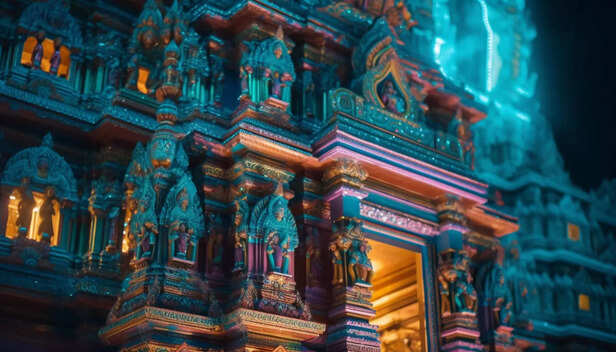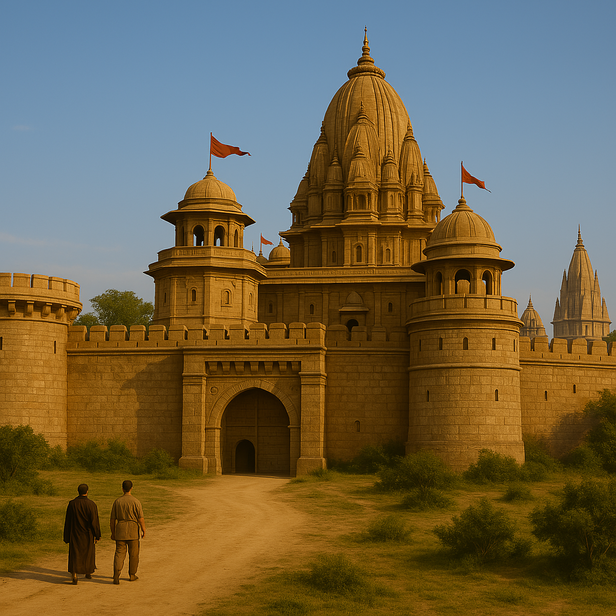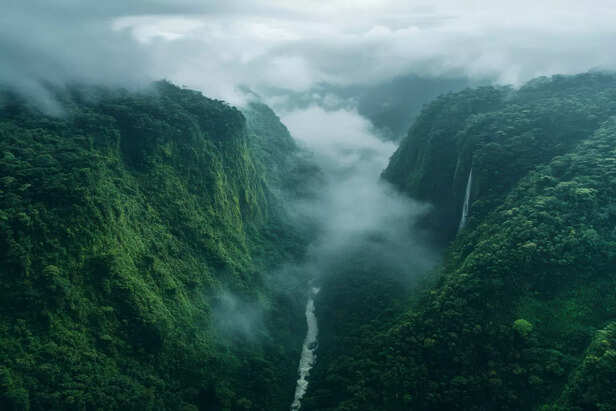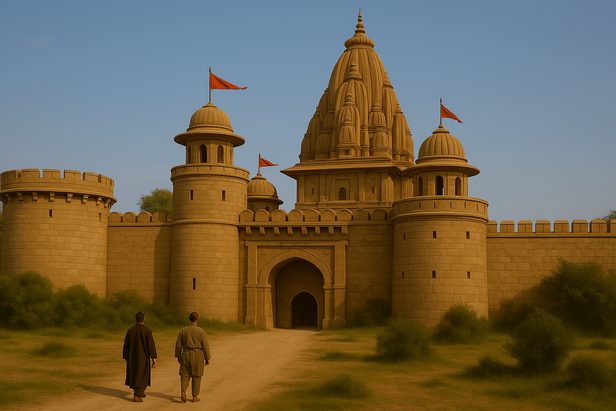What Happened to These 7 Lost Places from the Mahabharata?
Noopur Kumari | Apr 23, 2025, 08:00 IST
( Image credit : Times Life Bureau )
What if the most powerful cities from the Mahabharata simply vanished? From Indraprastha’s divine glow to Dwaraka’s watery grave, these 7 legendary places were once alive in our epics—but today, they’ve mysteriously disappeared. Were they ever real, or have they been swallowed by time and fate? Uncover the secrets, walk with the lost, and feel the past whisper through forgotten lands.
We hear tales of battles waged, countries vanished, and dharma put to the test as we grow up. A reflection of humanity's achievements, shortcomings, and unending yearning for justice, the Mahabharata is more than just a story. However, while we recall the personalities, what about the terrain they traversed? Ironically, a number of locations that are referenced in the Mahabharata—such as heavenly castles, cursed forests, and gorgeous cities—have never been discovered by historians or archaeologists. Did they really exist, or had time engulfed them, and were they just waiting to be found again? Let's explore these seven enchanted locations and perhaps, just perhaps, hear their stories being whispered once more.

According to legend, Vishwakarma himself constructed Indraprastha, the Pandavas' capital, which was a dazzling display of gems, illusions, and heavenly grandeur. It was said to be a city that was so prosperous and just that even Duryodhana was unable to tell the difference between the floor and water. No concrete proof has ever been discovered, despite the fact that many people think that Delhi today is where Indraprastha previously stood. Was time consuming it? Or concealed behind decades of contemporary society? Both the mystery and the desire to see the streets where Arjuna once reigned and Draupadi once wept are still unsolved.

The Lakshagraha, the wax castle constructed to murder the Pandavas, is what Varnavat is known for. They barely avoided death in this place of treachery, terror, and survival. The location of this area is still up for question, though. Historians cite regions of modern-day Uttar Pradesh as candidates, although no construction or site has proven it as Varnavat. The ground is good at concealing its secrets, and Varnavat appears to have been wiped out of history by the fire that attempted to destroy the Pandavas.

Hastinapur is the political hub of the Mahabharata, the seat of authority, and the residence of the Kauravas. According to legend, the Kuru bloodline passed through its gates and elephants roamed its royal pathways. Though much of what was described—the palaces, the grandeur—is buried underground or in ruins, modern-day Hastinapur in Meerut asserts this ancestry. Whether it was karma, floods, or earthquakes, Hastinapur vanished, leaving behind just pieces of its once-powerful soul.

The holy kingdom of Dwaraka, the capital of Krishna, was constructed on land that had been reclaimed from the sea. their inhabitants were blessed, and their beauty was renowned. However, as predicted, the city sunk when Krishna departed from this realm. Ancient structures discovered during underwater excavations close to Dwarka, Gujarat, have not been positively identified as the Dwaraka. Even the greatest of kingdoms must eventually return to dust—or water—as the sea protects its riches and what was once a glorious fantasy now sits mute and submerged.

The Pandavas dwelt in the enigmatic Kamyaka Forest during their exile, where time flowed slowly and sages mused. Even divine guests appeared in this wilderness of suffering and healing. However, there is no sign of Kamyaka today. According to some, it was located close to the banks of the Saraswati, a river that likewise vanished inexplicably. Only stories remain after the forest and river vanish, resonating faintly via holy writings and waning breezes.

The Pandavas resided covertly in Virat Nagar during their last year of exile, shielding themselves from both fate and their adversaries. Bhima became a chef, Arjuna a dancing instructor, and Draupadi a maid. A land of silent tenacity and royal masquerade.
Some draw a comparison between Virat Nagar and the ancient remains of Bairat, Rajasthan, today. However, there is no proof that this was the Pandavas' hidden sanctuary. The location where the heroes hid has now permanently disappeared, which is a poetic irony.
The Pandavas resided covertly in Virat Nagar during their last year of exile, shielding themselves from both fate and their adversaries. Bhima became a chef, Arjuna a dancing instructor, and Draupadi a maid. A land of silent tenacity and royal masquerade. Some draw a comparison between Virat Nagar and the ancient remains of Bairat, Rajasthan, today. However, there is no proof that this was the Pandavas' hidden sanctuary. The location where the heroes hid has now permanently disappeared, which is a poetic irony.
Maybe the earth shifted. Maybe the rivers changed course. Or maybe some places were never meant to be found. But one truth remains—these lost sites from the Mahabharata aren’t just geography. They are memories, morals, and mirrors. They remind us of how truth can hide, how history breathes, and how faith makes even the unseen, real. As we scroll through timelines and touchscreens, these ancient places whisper to us: "We were once real. And in your belief, we still are."
Explore the latest trends and tips in Health & Fitness, Travel, Life Hacks, Fashion & Beauty, and Relationships at Times Life!
1. Indraprastha – The Glorious Capital Built by the Gods

Indraprastha
( Image credit : Times Life Bureau )
According to legend, Vishwakarma himself constructed Indraprastha, the Pandavas' capital, which was a dazzling display of gems, illusions, and heavenly grandeur. It was said to be a city that was so prosperous and just that even Duryodhana was unable to tell the difference between the floor and water. No concrete proof has ever been discovered, despite the fact that many people think that Delhi today is where Indraprastha previously stood. Was time consuming it? Or concealed behind decades of contemporary society? Both the mystery and the desire to see the streets where Arjuna once reigned and Draupadi once wept are still unsolved.
2. Varnavat – The Place of the Deadly Wax Palace

Varnavat
( Image credit : Times Life Bureau )
The Lakshagraha, the wax castle constructed to murder the Pandavas, is what Varnavat is known for. They barely avoided death in this place of treachery, terror, and survival. The location of this area is still up for question, though. Historians cite regions of modern-day Uttar Pradesh as candidates, although no construction or site has proven it as Varnavat. The ground is good at concealing its secrets, and Varnavat appears to have been wiped out of history by the fire that attempted to destroy the Pandavas.
3. Hastinapur – The Throne of Kings

Hastinapur
( Image credit : Freepik )
Hastinapur is the political hub of the Mahabharata, the seat of authority, and the residence of the Kauravas. According to legend, the Kuru bloodline passed through its gates and elephants roamed its royal pathways. Though much of what was described—the palaces, the grandeur—is buried underground or in ruins, modern-day Hastinapur in Meerut asserts this ancestry. Whether it was karma, floods, or earthquakes, Hastinapur vanished, leaving behind just pieces of its once-powerful soul.
4. Dwaraka – Krishna’s Divine City Beneath the Sea

Dwaraka,
( Image credit : Times Life Bureau )
The holy kingdom of Dwaraka, the capital of Krishna, was constructed on land that had been reclaimed from the sea. their inhabitants were blessed, and their beauty was renowned. However, as predicted, the city sunk when Krishna departed from this realm. Ancient structures discovered during underwater excavations close to Dwarka, Gujarat, have not been positively identified as the Dwaraka. Even the greatest of kingdoms must eventually return to dust—or water—as the sea protects its riches and what was once a glorious fantasy now sits mute and submerged.
5. Kamyaka Forest – Where Exile Tasted Like Solitude

Kamyaka Forest
( Image credit : Freepik )
The Pandavas dwelt in the enigmatic Kamyaka Forest during their exile, where time flowed slowly and sages mused. Even divine guests appeared in this wilderness of suffering and healing. However, there is no sign of Kamyaka today. According to some, it was located close to the banks of the Saraswati, a river that likewise vanished inexplicably. Only stories remain after the forest and river vanish, resonating faintly via holy writings and waning breezes.
6. Virat Nagar – Where Draupadi Became a Maid

Vijay nagar
( Image credit : Times Life Bureau )
The Pandavas resided covertly in Virat Nagar during their last year of exile, shielding themselves from both fate and their adversaries. Bhima became a chef, Arjuna a dancing instructor, and Draupadi a maid. A land of silent tenacity and royal masquerade.
Some draw a comparison between Virat Nagar and the ancient remains of Bairat, Rajasthan, today. However, there is no proof that this was the Pandavas' hidden sanctuary. The location where the heroes hid has now permanently disappeared, which is a poetic irony.
7. Kurukshetra’s Original Battlefield – The Heart of Dharma Yudh
The Pandavas resided covertly in Virat Nagar during their last year of exile, shielding themselves from both fate and their adversaries. Bhima became a chef, Arjuna a dancing instructor, and Draupadi a maid. A land of silent tenacity and royal masquerade. Some draw a comparison between Virat Nagar and the ancient remains of Bairat, Rajasthan, today. However, there is no proof that this was the Pandavas' hidden sanctuary. The location where the heroes hid has now permanently disappeared, which is a poetic irony.
When Places Vanish, Stories Live On
Explore the latest trends and tips in Health & Fitness, Travel, Life Hacks, Fashion & Beauty, and Relationships at Times Life!
